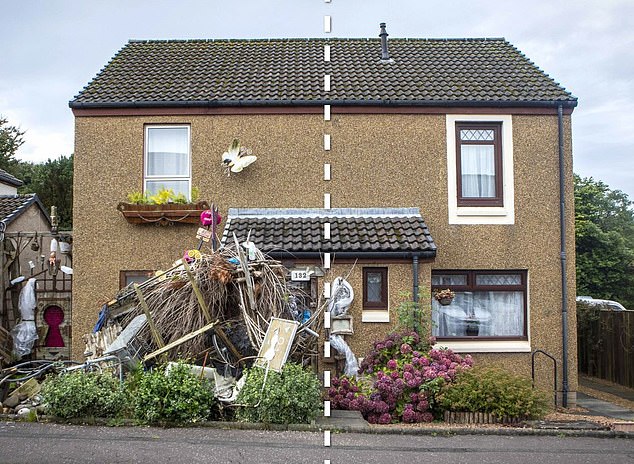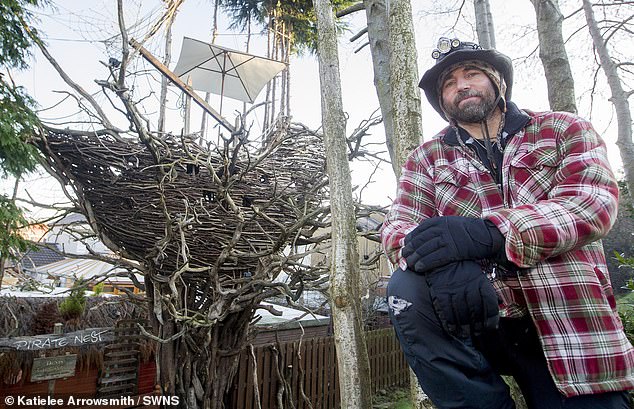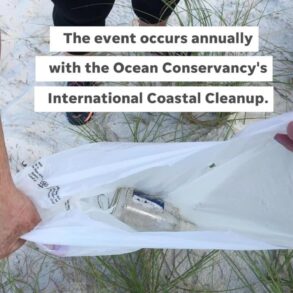When John Kirby put his elderly mother’s home on the market to pay her care home fees, he should have been guaranteed an easy sale.
The semi-detached property is tucked away in a desirable pocket of the popular coastal town of Dalgety Bay, a nine-mile commute from Edinburgh. It is close to schools, has great transport links and there are myriad amenities on its doorstep.
Indeed, most viewers who crossed the threshold of the £160,000 property said they would gladly snap it up but for one major deal breaker – the house of horrors next door.
It is not a hyperbolic description, given the macabre monstrosity artist Denis Carbonaro has made of the neighbouring home.
His ‘artistic statement’ includes burying a shopping trolley and rusty pram under piles of rubbish in his front garden; noxious signs on his trees vilifying passers-by as ‘human rats’ and – the most disturbing of all – a baby doll impaled on his gate with nails hammered through its eyes.



Mr Kirby, 61, is appalled that this ghastly ‘eyesore’ is preventing the sale of a house his parents worked hard for.
His mother, who we are not naming, was widowed in 2011 and it was painful for her son to put her in a home last year after she developed Alzheimer’s and could no longer cope on her own.
She is a retired civil servant and had managed to build up a healthy nest egg but her savings have now been spent on her care, leaving Mr Kirby with no alternative but to sell the home she lived in for almost 40 years.
When the property went up for sale two months ago, Mr Kirby was hopeful he could reason with Mr Carbonaro, given the neighbours had an amicable relationship.
But Mr Kirby said: ‘When I knocked on his door and very politely asked if he would clean up the outside of his house, he became verbally aggressive.
‘I realised I was getting nowhere and left. I was so angry.
‘It is an eyesore and dumping all that clutter in a garden is no better than fly-tipping. I have tried everything to get him to clean it up but nothing works. I feel powerless.’
Mr Carbonaro’s latest creation belies the reputation he earned as a talented artist soon after moving into the street in 2015.
He had immigrated to Scotland from Sicily 25 years ago and worked as a web designer until he suffered burn-out.
Turning to his passion for art, he began fashioning elaborate creations in his garden: a woolly mammoth of cypress branches; a giant spider made from discarded wood and a galleon crafted from twigs which he placed in the trees at the end of his garden.
The innovative installations attracted such a positive reaction he opened a mini theme park, which grew so popular it was listed on Tripadvisor as a top attraction in the area.
In media interviews the artist generously declared that although he welcomed donations from visitors to his ‘Bark Park’, his real reward was the appreciative ‘wows’ from admirers of his work, who included Mr Kirby.
The retired electrical engineer said: ‘I thought his installations were quite ingenious. I loved them but my mum hated them because she thought they would devalue her house.
‘Turns out, she was right.’ For a while Mr Carbonaro seemed to love welcoming visitors to his makeshift park, taking children on tours through the garden, while dressed in the costume of Haggis, his furry alter ego.
But he claimed that when around 80 children visited, through a series of bookings in 2020, their parents’ failure to donate was tantamount to ‘theft’ of his intellectual property.
The perceived slight appeared to trigger a personality change in Mr Carbonaro and he transformed from a whimsical artist to a seemingly embittered character. He condemned the visiting groups as ‘toxic families’ who ‘didn’t leave a single penny for my efforts’.
Tripadvisor reviews, which were once glowing, began to reflect the artist’s frequent angry outbursts.
The reviews told of parents and children being loudly berated for looking at the installations without paying, despite the work being clearly visible from the street.
One mother said Mr Carbonaro delivered a furious tirade when her child stopped to look at the installations from the public coastal path running along the back of his house. The mother wrote: ‘It is rude to treat people that way, and especially kids.
I have considered a donation but having been approached that way, not only will I avoid the place in future but I will discourage others from going.’
In an extraordinary response Mr Carbonaro then accused passers-by of being stalkers and invading his privacy by ‘peeping’ and ‘spying’ on his property.
As his behaviour grew increasingly erratic, the artist neglected his installations and his garden became a dumping ground of discarded metal and wood from his art.
He erected sinister signs in his garden making the unfortunate comparison between himself and the medieval story of the Pied Piper of Hamelin.
The folk tale recounts how the Piper was hired by the towns- people of Hamelin to lure rats away with his magic pipe, but when the town refused to pay his fee he retaliated by using his instrument’s power to lead their children away instead.
Mr Carbonaro’s signs were headed ‘Pay the piper’ and underneath he wrote a diatribe: ‘No rats, no parasites, no toxic prats.’ He also scrawled ‘no pay, no rats’ on the torso of the baby doll nailed to his gate.
In one display in January this year, he set off sirens in his garden and, through a loud hailer, denounced Dalgety Bay as ‘a town infested with human rats’.
Mr Kirby said: ‘He has become more and more aggressive as time has gone on. It is impossible to reason with him.’
When Mr Kirby emailed Mr Carbonaro in yet another attempt to reach an agreement, the artist condemned him for also having viewed the artwork for free from his mother’s garden.
The artist claimed that but for people’s meanness he could have afforded to buy the property himself from Mr Kirby.
And, remarkably, he blamed the lack of a sale not on the negative impact of his mess but on the house requiring modernisation.
However, Mr Kirby said an estate agent told him that if it were not for the neighbour’s unsightly garden he could probably achieve well over the asking price for the property.
A recent survey of estate agents found 88 per cent agreed that the appearance of a neighbour’s property impacted on the price a house could fetch.
Kerb appeal was also listed as a crucial consideration in a sale.
Neither factor is likely to prove positive for Mr Kirby’s sale any time soon.
Mr Carbonaro said he was refusing to end his campaign, which he is calling ‘Wows Don’t Grow on Trees, Garbage and Clutter Do’.
He recently escalated his protest, saying he will put a piece of garbage in his garden for every person who has enjoyed his work and not donated.
The artist has filled his garden with even more rubbish, nailed an old shoe to his front door, constructed a wind chime out of yoghurt cartons and fixed a frying pan to his front wall.
He wrote in an email to Mr Kirby: ‘The campaign is a result of the repeated invasion of my privacy by rats like you.’
He signed it ‘The Unpaid Piper of Dalgety Bay’.
Mr Kirby wrote to his MSP Annabel Ewing to ask if she could help push for a clearance of Mr Carbonaro’s garden and she contacted various Fife Council departments on his behalf.
But officials from housing and environmental health advised that as no laws had been broken, no action could be taken.
Mr Kirby received a similar response when he contacted Police Scotland and the fire service, claiming the property was a potential safety hazard.
He said: ‘I am running out of options. I feel like I am banging my head against a wall. I really find it incredible that he can get away with creating such a mess. I can’t believe he is not breaching some kind of legislation.
‘If that really is the case, then the legislation needs changed. It is a horrendous situation.’
Local councillor David Dempsey also contacted officials at Fife Council but as all the rubbish is Mr Carbonaro’s private property, they said nothing could be done.
Cllr Dempsey said that over the years he has been contacted numerous times by locals with complaints about Mr Carbonaro.
Nearby residents reported Mr Carbonaro’s disturbing use of sirens and loud hailers, and police warned the artist that he would be breaching noise pollution rules if he continued to use the sound equipment.
But Cllr Dempsey said that it had proved impossible to force Mr Carbonaro to clean up his garden.
He said: ‘There appears to be no legislation that can make a clean-up happen.
‘There is a right thing to do but there appears to be no legal route to enforcing it. It is incredibly frustrating.’
Until the house is sold, Fife Council is paying the £6,000 monthly care fees for Mr Kirby’s mother.
When Mr Carbonaro was contacted yesterday by the Daily Mail, he apologised for ‘any frustration that the Kirby family might be experiencing’.
He said: ‘I sympathise with the urgency of their situation.
‘However, it’s important to clarify that for the past nine years I have been the victim of ongoing disrespect for my privacy and my intellectual property.
I fully acknowledge that the campaign may seem chaotic and provocative, but it is intended to raise awareness of the systemic disrespect and disregard for my rights over the years.’

Far from being just a mess, the rubbish in his garden had been curated especially for his protest, he claimed.
Mr Carbonaro said: ‘Regarding the accusation of “fly-tipping”, I must emphasise that these items are part of a deliberate activist campaign and hold significant meaning.
‘The clutter John refers to is in fact a creative statement against the exploitation I have experienced from neighbours and visitors alike, who have failed to offer support despite enjoying the installations.’
Mr Carbonaro complained that despite its popularity, Bark Park had never been recognised officially as a tourist attraction.
He said: ‘This lack of recognition has caused many to treat it as public domain, even though it is a private home and an evolving open-air gallery.’
The artist added: ‘As its creator, I live here, protecting my intellectual property rights and “hoping” to make a modest living from my work.’
This post was originally published on this site be sure to check out more of their content





